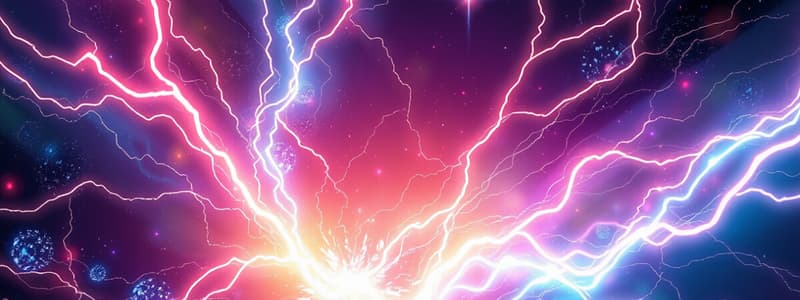Podcast
Questions and Answers
What does Coulomb's Law describe?
What does Coulomb's Law describe?
- The force between two static charges. (correct)
- The energy stored in a capacitor.
- The voltage between two points in a circuit.
- The magnetic field around a current-carrying wire.
In Coulomb's Law, what happens when like charges are brought close together?
In Coulomb's Law, what happens when like charges are brought close together?
- They create a magnetic field.
- They become neutral.
- They attract each other.
- They repel each other. (correct)
What is the unit of electric field strength?
What is the unit of electric field strength?
- Amperes per volt.
- Watts per meter.
- Newtons per Coulomb. (correct)
- Joules per Coulomb.
Which formula correctly describes the electric field due to a point charge?
Which formula correctly describes the electric field due to a point charge?
What does the superposition principle in electrostatics state?
What does the superposition principle in electrostatics state?
Which statement about electric field lines is true?
Which statement about electric field lines is true?
Flashcards are hidden until you start studying
Study Notes
Electrostatics Study Notes
Coulomb's Law
- Definition: Describes the force between two static charges.
- Formula: ( F = k \frac{|q_1 q_2|}{r^2} )
- ( F ) = magnitude of the force between charges
- ( k ) = Coulomb's constant (( 8.99 \times 10^9 , \text{N m}^2/\text{C}^2 ))
- ( q_1, q_2 ) = magnitudes of the charges
- ( r ) = distance between the centers of the charges
- Direction of Force:
- Like charges repel; opposite charges attract.
- Superposition Principle: The total force on a charge is the vector sum of the forces exerted by all other charges.
Electric Field
- Definition: A region around a charged object where other charges experience a force.
- Formula: ( E = \frac{F}{q} )
- ( E ) = electric field strength
- ( F ) = force experienced by a test charge
- ( q ) = magnitude of the test charge
- Units: Newtons per Coulomb (N/C) or Volts per meter (V/m).
- Electric Field due to Point Charge:
- ( E = k \frac{|q|}{r^2} )
- Direction:
- Points away from positive charges and towards negative charges.
- Field Lines:
- Represent the direction and strength of the electric field.
- More lines indicate stronger fields.
- Lines do not cross.
- Uniform Electric Field:
- Same strength and direction throughout (e.g., between two parallel plates).
These notes provide a concise overview of Coulomb's Law and Electric Field concepts in electrostatics.
Coulomb's Law
- Definition: Governs the electrostatic force between two stationary charges.
- Formula: ( F = k \frac{|q_1 q_2|}{r^2} )
- ( F ): Magnitude of the electrostatic force.
- ( k ) (Coulomb's constant): ( 8.99 \times 10^9 , \text{N m}^2/\text{C}^2 ).
- ( q_1, q_2 ): Charges involved in the interaction.
- ( r ): Distance separating the charges' centers.
- Force Direction:
- Like charges repel each other while opposite charges attract.
- Superposition Principle: The net force on any charge equals the vector sum of forces from all other charges acting on it.
Electric Field
- Definition: An area surrounding a charged object where other charges experience a force.
- Formula: ( E = \frac{F}{q} )
- ( E ): Electric field strength.
- ( F ): Force on a test charge placed in the field.
- ( q ): Magnitude of the test charge used.
- Units: Measured in Newtons per Coulomb (N/C) or Volts per meter (V/m).
- Electric Field from Point Charge:
- Given by ( E = k \frac{|q|}{r^2} ) for a point charge.
- Direction of Electric Field:
- Originates from positive charges and terminates at negative charges.
- Electric Field Lines:
- Visual representation indicating both direction and intensity of the field.
- The density of lines signifies the strength of the field; more lines indicate a stronger field.
- Lines never intersect.
- Uniform Electric Field:
- Characterized by consistent strength and direction throughout the field, as seen between two parallel plates.
Studying That Suits You
Use AI to generate personalized quizzes and flashcards to suit your learning preferences.




